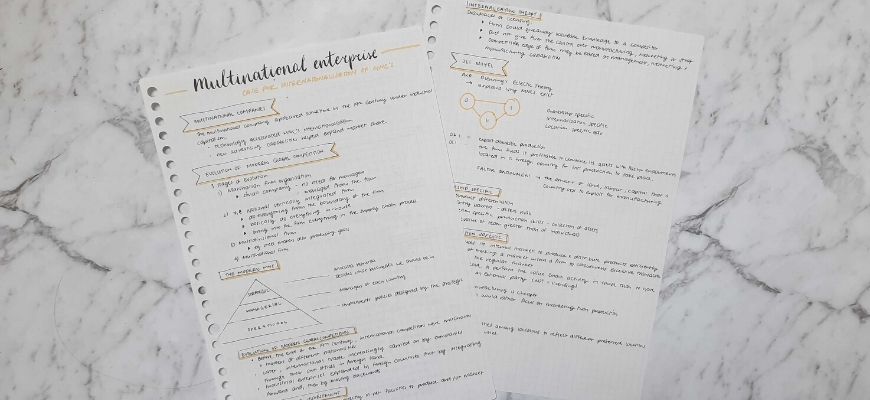Want to create perfect study notes but don’t know where to start? in this article, we’ll break down two detailed methods for note-taking step-by-step. We also canvas other popular methods before explaining the best methods for getting the most out of your exam-conquering notes!
The ultimate guide to writing perfect notes
Good notes make for good marks, perfect notes make for perfect marks (or close to!). Making perfect notes is an investment in time and your future. If you want that 99.95 ATAR or the A+ or Band 6 result, it all starts with excellent notes. And that means commitment.
If you want to do well and want the notes to help you get there, then there aren’t really any short-cuts! There’s just consistent habits and grind.
This is a good thing because it means anybody can achieve great marks, they just need to do the work! In this article, we’re going to break down what goes into this.
If you don’t want to have to commit to one style. Don’t worry, after we show you the processes, we’re going to look at a few different styles. in addition, we’ll look at plenty of examples on the way.
However, we do insist that when you do write notes you write them by hand. Research consistently shows that handwritten notes encourage and support recall and visualisation.
Let’s get started!
In this article, we’ll discuss,
- Writing perfect notes for different purposes
- How to write perfect text, textbook, or source notes step-by-step
- How to write perfect class and lecture notes step-by-step
- Other styles
- Split Page
- Cornell Method
- Q/E/C – Question, Evidence, Conclusion
- Flow Method
- How to utilise your perfect notes
- Memorisation
- Practice responses
- Quizzes
- Summarising
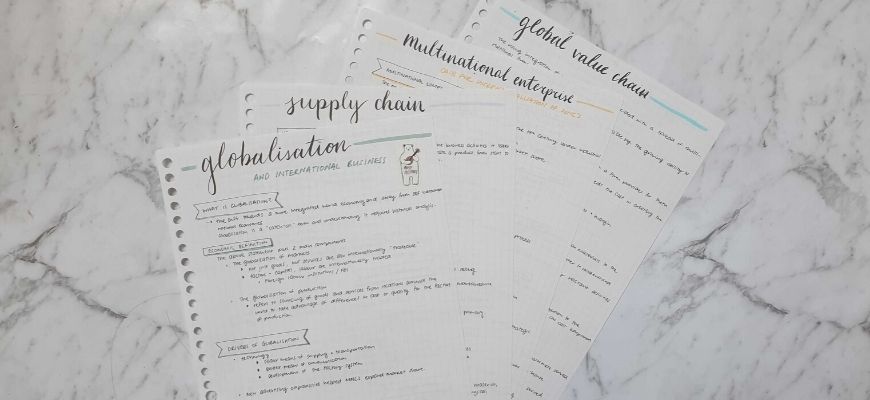
Writing perfect notes for different purposes
Depending on your purpose, how you make your notes is clearly going to differ.
You’ll do one thing for texts and textbooks but something different for in-class or lecture notes.
Text summaries and textbook notes tend to be more polished and produced over a couple of hours and iterations.
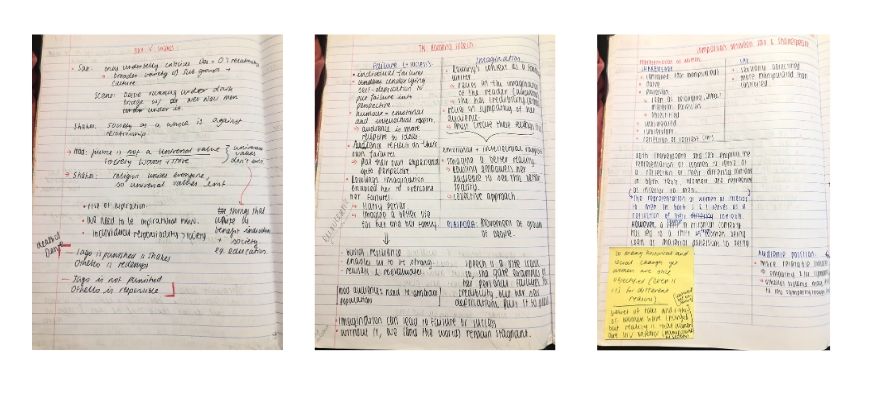
Don’t wish your notes were clear, like these?
Class and lecture notes are often messy and thrown together quickly, requiring rewriting and organisation.
Let’s take a look at both methods.
How to write perfect text, textbook, or source notes
Writing notes isn’t something that happens in one step or one sitting. Instead, you need to commit time to them. Let’s look at what’s involved in writing notes from texts and text books.
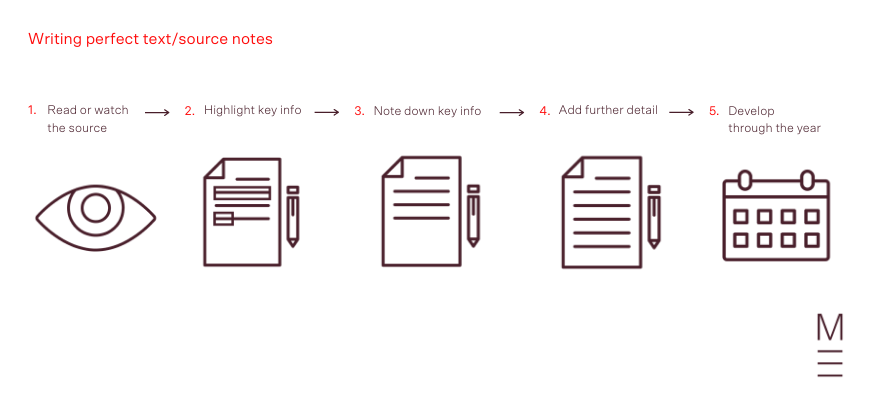
Use this method to make notes about texts or from textbooks!
OK. Now you’ve seen the process let’s look at it in more detail!
Step 1: Read/watch the source
Before you write notes, you need to have information. You need to start with some source material. This can be the novel set for study, your Maths textbook, or your Science textbook.
Ideally, read the text through once, and then go back through and read again to start highlighting/underlining key info.
Step 2: Highlight important info
Highlight relevant information and passages.
Knowing the content broadly will help you decide what you need to focus on.
It may be tempting to highlight everything. But it’s not all key information. Focus on the essential details. This will help you learn information as you write notes.
Step 3: Summarise the content
Now you want to start creating notes. It helps to start with headers and expand on headers with dot point summaries of information.
Different subjects will warrant different ways of developing this.
Try and utilise note-taking methods that suit the content. English notes may benefit from tables for connecting information to text, techniques, and Module concerns.
For example, Maths notes might focus on methods and equations.
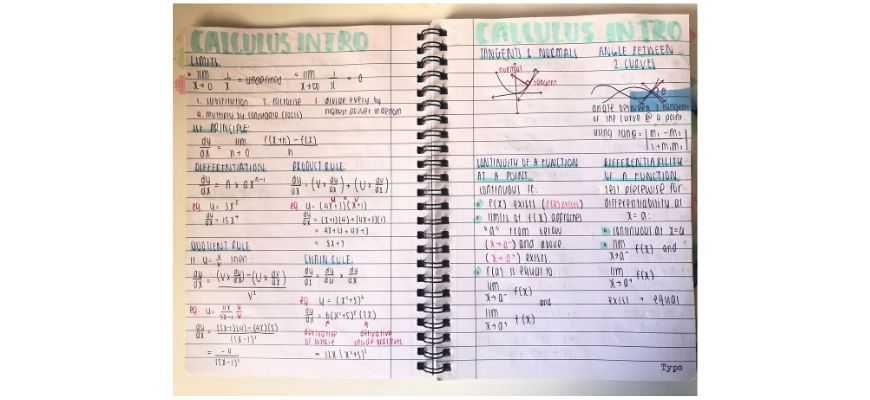
Step 4: Add additional notes (eg. things I need to remember, analysis, additional research)
Don’t leave your notes to sit, add to them consistently. When adding further information, make sure you read through your existing notes.
Reading your existing notes before adding more notes helps entrench knowledge!
Adding your most recent ideas, discoveries, or hacks to a set of notes keeps it a live document.
Step 5: Keep adding onto them throughout the year
As the year progresses, develop your notes further with more information and ideas. Notes are important for studying and revision.
One method Matrix students find useful is trying to condense notes down to cheatsheets or summary sheets.
These function as good revision notes and are excellent resources for revision.
It’s one thing to take notes about a text or novel or film, but something else to make notes about a class or lecture!
How to write perfect class and lecture notes
Making notes in class or lectures requires focus and the ability to condense a lot of information into manageable chunks. We tend to write far slower than other people speak. This means we need to be judicious when taking notes so as not to miss key points or get bogged down and miss great swathes of a class.
People speak at an average of 130-150 words a minute compared to handwriting notes at an average of 120-155.
So what does this method look like?
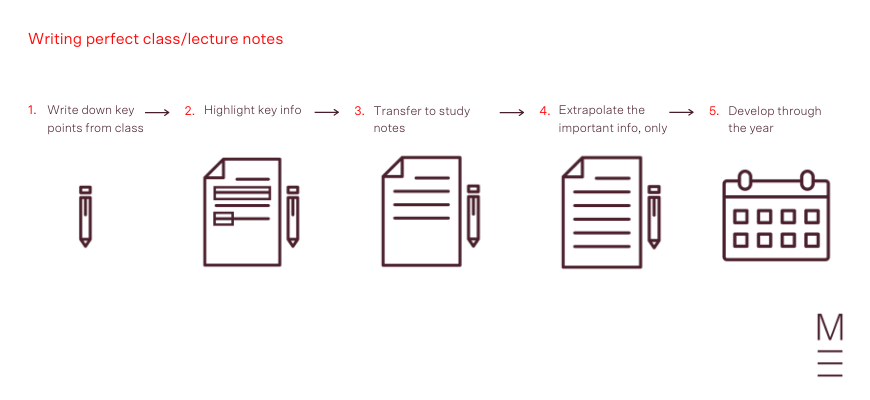
Use this step-by-step process for taking in-class notes.
What we’ll do now is describe this efficient and effective process for taking class notes.
Step 1: Write down key things your teacher says in my first set of rough notes
When the teacher, or lecturer, is speaking and describing things or processes, focus on writing keywords and key statements, first.
Trying to write everything will mean you miss most of it.
You want to make initial notes around key ideas. use the moments where your speaker pauses to start adding further information. You may find that Cornell or flow systems are the most effective ways to develop class notes.
Remember, the key focus is covering the important details, not all the information. This is the first step, so don’t get anxious or stressed if you miss things, there will be time to try and fill in the blanks.
Step 2: Highlight the most important things (eg. formulas). Try and do this in class, if you have time.
You want to highlight the most important facts, ideas, or pieces of data while they are fresh in your mind.
Try and go through your notes in-class and highlight the salient points.
If you run out of time in class, try and find an opportunity to highlight things at school while things are fresh. This will act as a trigger when you transcribe and expand things later!
Step 3: At home, transfer these notes into revision notes
Now you’ve got base notes, you’re in a position to develop this information further.
First, transcribe the major in-class information. Begin with the keywords you highlighted, copy that across and then add the surrounding detail from your class notes.
Step 4: Only extrapolate the most important info
Once you’ve got the basic info down, fill in the blanks.
Use the missing information as a launchpad to researching further details. This may mean reading a textbook or novel and developing notes from that source (see above). Stay focused on the keywords and ideas you highlighted when developing notes. If you encounter an interesting idea, make a note and return to it later!
Don’t get distracted by interesting rabbit holes when you’re trying to produce notes and resources for later study.
If you find you have questions that aren’t resolved as you transcribe your notes, write these down. You want to take these along to your next class or contact your teacher or tutor about them for assistance.
It’s okay if you have questions after making notes to this point, it’s a key part of the process. Not following up on those questions, though, is a critical mistake!
Don’t try and cram everything into one page!
Leave space in your notes to include the information you are missing.
Step 5: Add any extra notes (eg. things you need to remember, analysis, or additional research)
Make sure you follow up on the questions that you have! You want to add that information later.
You want to keep adding to your notes:
- Questions you have
- Answers to those questions
- Additional points you need to remember
- Interesting pieces of research
Remember, every time you add to your notes, take the time to read your existing notes.
Other styles of note-taking
The methods above aren’t the only methods for making notes. There are some other popular and effective methods for taking and organising notes. Let’s have a gander at them.
Split page notes
As the name suggests, these are notes where the page is split in half.
- On the left side, include the keywords or headers you can use as triggers
- On the right side, include dot-point summaries and quotations
Once you’ve completed your notes, you can easily cover the summary side and tried to recall the information prompted by the keyword or header.
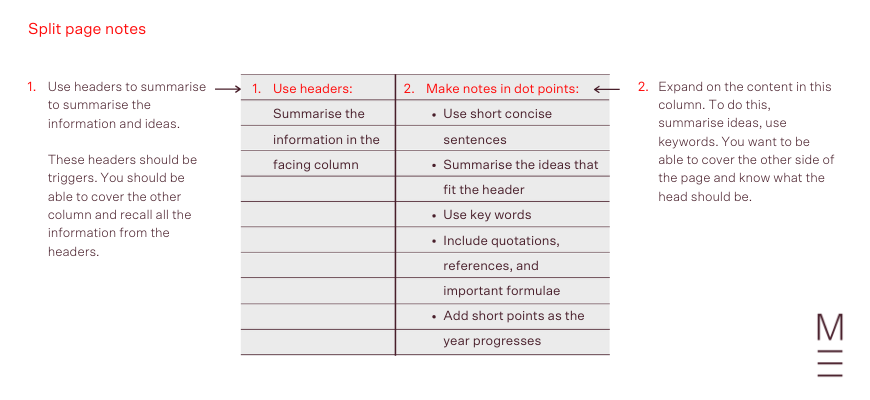
The best layout for Split Page notes
Split page notes are great for developing revision notes or summarising STEM textbooks.
Cornell Method – Notes, Keywords, Summary
The Cornell Method is famous and it is named after the university where it was developed. It is similar in concept to the split page method, above.
To use this method, follow the following steps:
- Divide the page into three. Have a 1/4 width margin dividing left and right sides of the page and a separating the bottom 1/6 of the page
- Use the left of the page for questions and headers
- Use the right of the page to summarise information
- Employ the area at the bottom of the page to summarise the information above.
In practice, this will look like this:
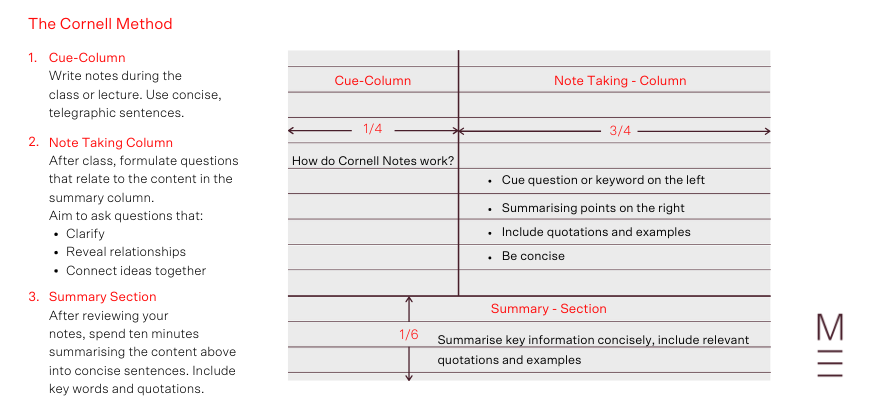
An example of laying out Cornell notes
When summarising the information, try to include key quotations and formulae while including the keywords. The Cornell method is really effective for taking in-class or lecture notes.
QEC – Question, Evidence, Conclusion
QEC notes develop information with an eye to putting together arguments or writing essays. The acronym, QEC stands for Question, Evidence, Conclusion.
QEC notes begin each section with a question. The information that follows is there to support a response to that question. The final part is a concluding statement. The conclusion should function like either a summary or thesis statement in response to the question.
So, what’s the process for producing these?
- Divide the page into two or three sections
- In each section, begin with a question
- Below the question, write concise dot-point notes
- Include key quotations, facts, and formulae (where required)
- For the conclusion, write either,
- A statement summarising the information above in response to the question
- A thesis statement or topic sentence that is a direct response to the initial question that encapsulates the information above.
This method will leave you with notes looking like this:
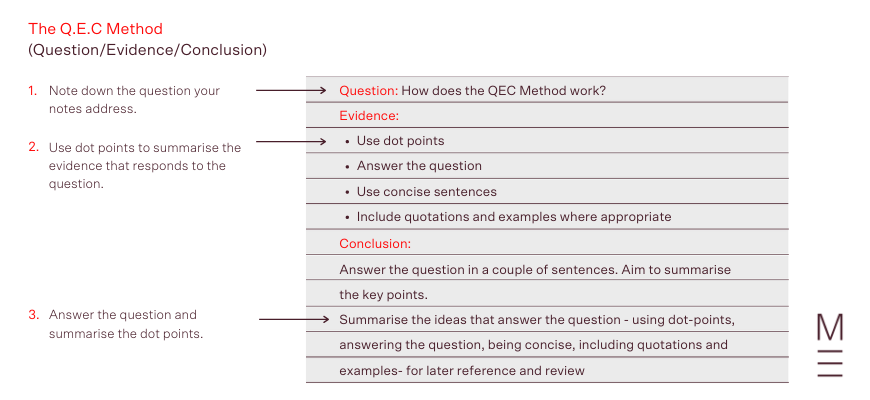
An example of Question/Evidence/Conclusion (QEC) notes.
QEC notes are great for humanities subjects – English, History, Economics – and also STEM subjects.
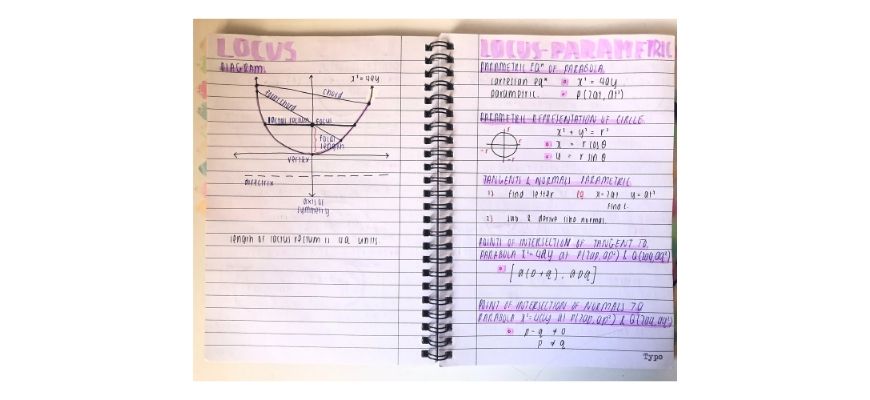
Flow method
The Flow method isn’t as neat and structured as the methods above. Instead, it is a way to create free-flowing notes on the go!
To produce flow notes, you want to think about the process behind producing a mind-map. But rather than making a mind-map, you want to create some flowing ideas.
How do you go about this?
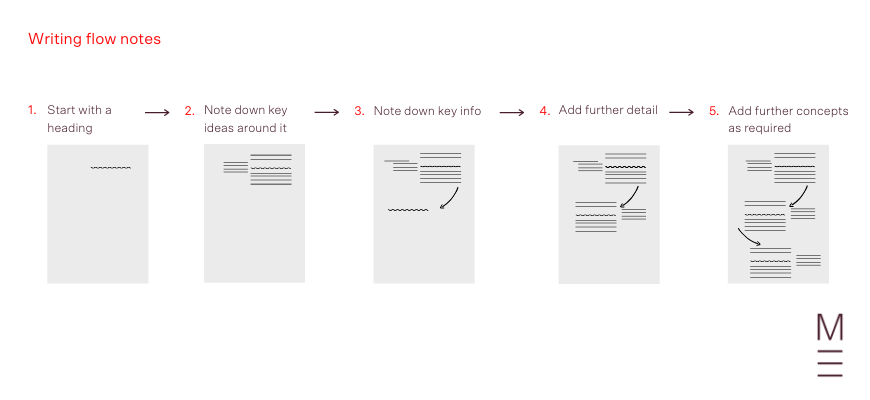
The process for producing flow notes.
Okay, let’s expand on this process:
- Begin with a keyword
- Expand on those ideas in a bubble around the keyword
- Nearby on the page, in an area with some blank space, write down the next keyword
- Connect it to the first with an arrow
- Expand your notes around the second keyword as you did the first
- Rinse and repeat as you connect and expand on subsequent notes.
This method is great for producing lecture notes, but as it is not as structured, the notes can be difficult to follow and develop later.
A significant flaw with flow notes, however, is that they can get messy and disorganised.
Making the most out of your perfect study notes
Having great or pretty notes is one thing, learning how to make the most of them to ace your exams is something else entirely. What we’ll look at now are the study methods you should follow to make the most of your perfect study notes to ace your assessments!
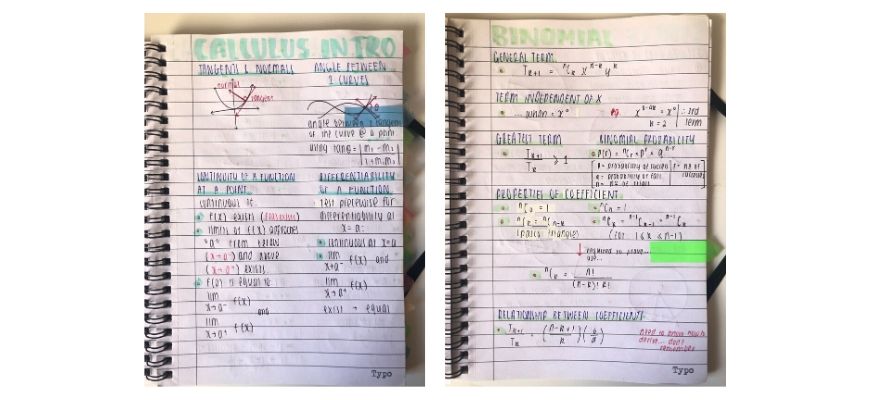
Memorisation
The key purpose of notes is to memorise information. You should set aside time each week to read through your notes and try and commit things to memory.
Don’t do this in one sitting, try and do it in smaller chunks!
The aim is not to memorise masses of information in one sitting, it is to memorise all the key information accurately!
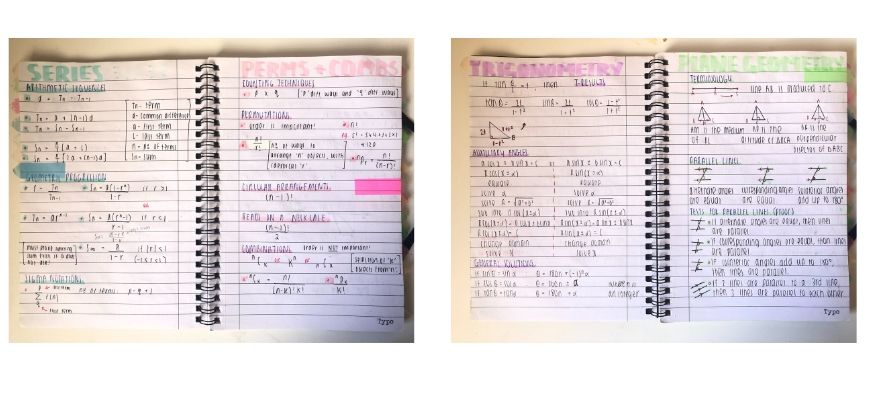
Memorisation is essential for recalling information in exam conditions, so you must find the time for this.
Practice responses
Writing practice responses helps you develop your ideas and memorise information.
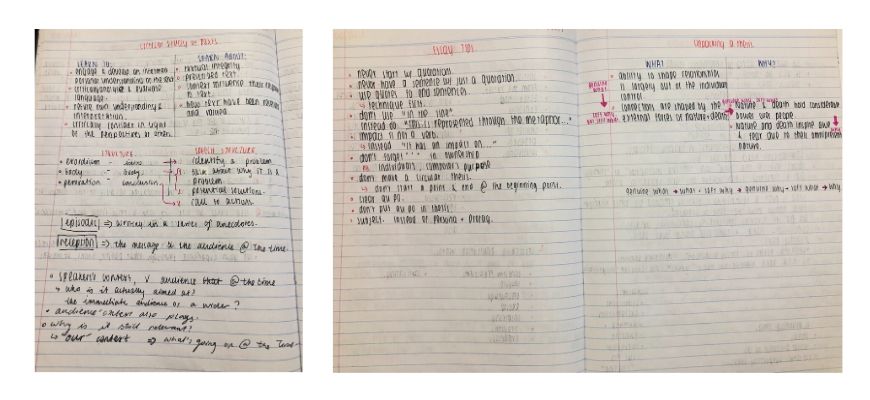
Because of how the brain is ‘plastic’, that is, it is malleable and can change to accommodate more information, writing information down is a good way of cementing learning.
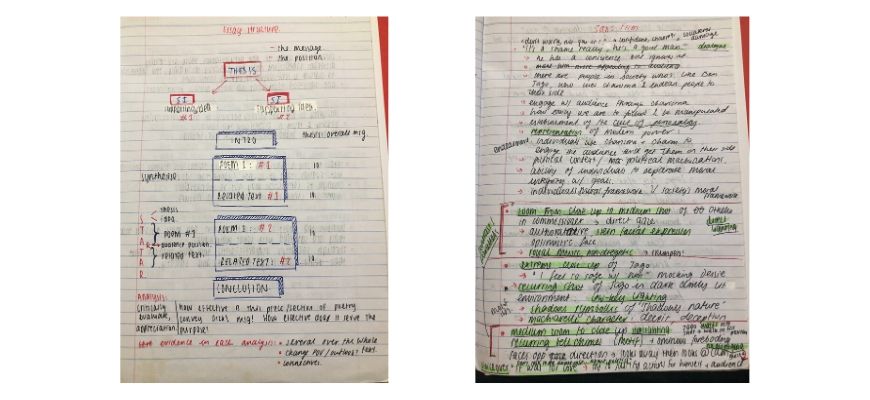
The act of writing responses and essays, especially handwriting rather than typing, functions as higher-order thought.
Writing essays is thinking as well as entrenching information – the more responses you write, the more you memorise and devlop your ideas.
In addition, because of the nature of most HSC exam questions being developed to prevent students from memorising essays, writing a variety of practice essays will help you prepare more effectively!
Quizzes
Cornell notes and split page notes are great for quizzing yourself. But even if you use other methods, you should use your notes to quiz yourself.
If you use Cornell or split page notes, you can simply cover the detailed side of the notes and then use the keywords or questions on the left to test yourself.
If you are using other forms of notes, you may want to write some questions to quiz yourself with. Otherwise, you can always ask a family member or friend to help you by quizzing yourself.
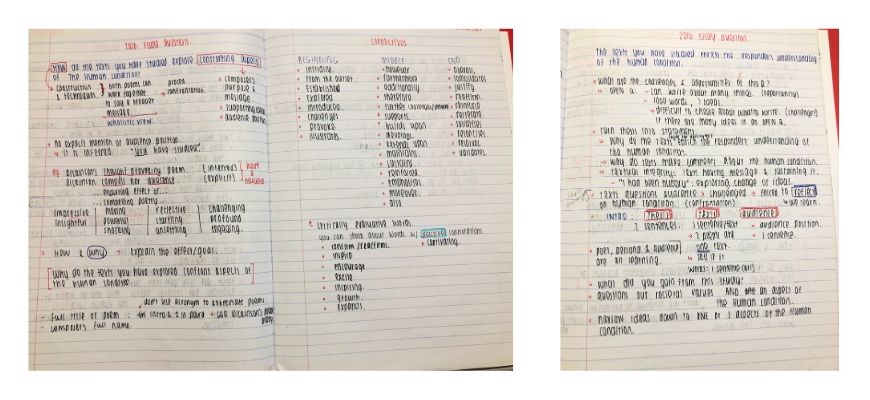
Summarising
This is an essential process for all notes. You don’t want to have produced some perfect notes and then think – “I’m done now!” That’s not how studying works!
Instead, you should try and summarise your notes to make them more concise and condensed.
Summarising notes will help you memorise the information.

